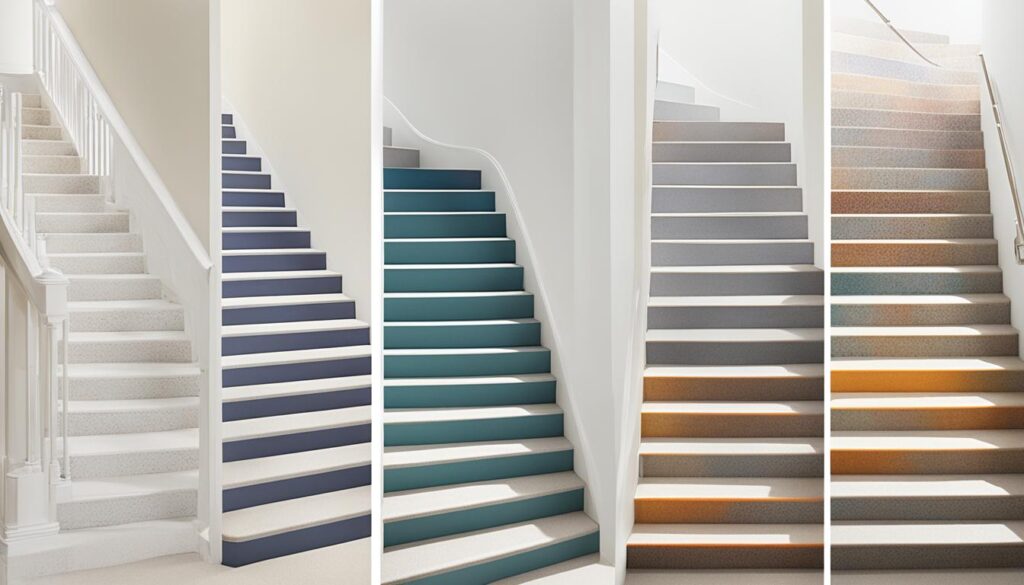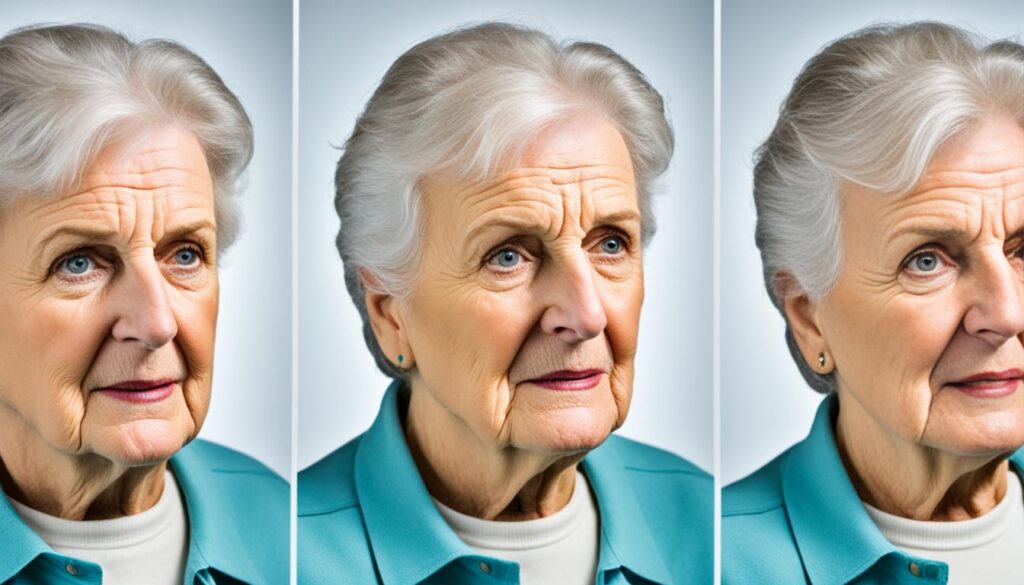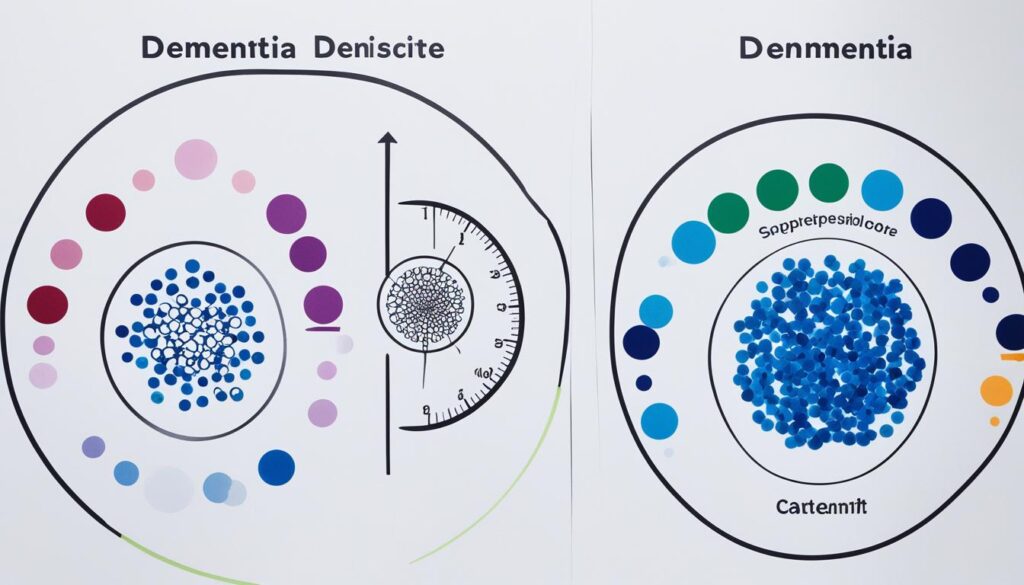Did you know that around 40% of Americans over 65 have age-related memory problems, making up nearly 16 million people1? Interestingly, only 1% of them will develop dementia each year1. For those in healthcare and caregiving, it’s vital to grasp the basics of rapid cognitive decline. Knowing how to use the Functional Assessment Staging Tool (FAST) is key.
Dr. Barry Reisberg created the FAST scale dementia tracking tool, as it is like Alzheimer’s, gets worse over time1. It looks at how well someone can do daily tasks and sees how this changes, giving important details to those taking care of them2. Using the FAST scale helps in planning personal care, making it very important in managing dementia.
Key Takeaways
- About 40% of individuals aged 65 or older in the United States have age-associated memory impairment1.
- Only 1% of people with age-associated memory impairment progress to dementia each year1.
- Dr. Barry Reisberg developed the FAST scale to evaluate the progression of dementia.
- The FAST scale focuses on assessing functional capabilities and their decline over time2.
- It provides critical insights for healthcare professionals, caregivers, and family members2.
What is Fast Scale Dementia?
The Functional Assessment Staging Tool (FAST) is vital for understanding cognitive decline in dementia. It was created by Dr. Barry Reisberg in the 1980s. The FAST scale precisely defines dementia stages34. It covers seven stages, from no impairment to total dependence35.
Definition and Origin
The fast scale dementia definition focuses on grading dementia systematically. Dr. Barry Reisberg introduced it in a 1985 article4. The scale identifies different levels of cognitive and functional impairment. This helps families and caregivers adapt care plans35. It’s critical for managing diseases like Alzheimer’s4.
- Stage 1: No cognitive decline.
- Stage 2: Very mild cognitive decline.
- Stage 3: Mild cognitive decline.
- Stage 4: Moderate cognitive decline (early-stage dementia).
- Stage 5: Moderately severe cognitive decline (mid-stage dementia).
- Stage 6: Severe cognitive decline (mid-stage dementia).
- Stage 7: Very severe cognitive decline (late-stage dementia).
Purpose and Importance
The FAST scale has many purposes. It helps to assess how dementia progresses3. It’s not just for doctors to use but also helps families see the level of cognitive decline3. Knowing this, caregivers can change care to fit the patient’s needs35.
A FAST score of 7A or more means very advanced dementia, often requiring hospice care5. This is essential for figuring out hospice eligibility. It gives patients and caregivers clear information54.
Knowing how to use the FAST assessment leads to better care for patients3. The adapted fast scale dementia works for different dementia types, showing their unique aspects54.
| Stage | Description | Example Functions Lost |
|---|---|---|
| 1 | No cognitive decline | No observed functional loss |
| 2 | Very mild cognitive decline | Forgetfulness of names or locations |
| 3 | Mild cognitive decline | Difficulty remembering recent events |
| 4 | Moderate cognitive decline | Challenges in complex tasks |
| 5 | Moderately severe cognitive decline | Assistance required in daily activities |
| 6 | Severe cognitive decline | Significant memory issues and trouble with basic tasks |
| 7 | Very severe cognitive decline | Loss of ability to communicate and perform basic functions |
Stages of the Fast Scale in Dementia
The FAST Scale breaks down dementia’s impact into seven levels. It’s a guide to understanding how severe dementia is in someone. From just starting to forget things to needing full-time care, this scale helps caregivers and medical teams plan better care.
Early Stages: Mild Cognitive Impairment
The start of the dementia fast scale stages shows Mild Cognitive Impairment (MCI). People in this phase start forgetting things and struggle with harder tasks. They might be in this stage for 2 to 7 years6. This period can also stretch up to 7 years as per the Global Deterioration Scale (GDS)7. Starting treatments early, like certain medicines, could help keep their mind sharp longer8.
Middle Stages: Increased Dependency
When dementia gets to the middle stages, people need more help with everyday things. Take Stage 4, or early dementia, which can last about 2 years6. Now, they might have trouble with money or planning their day. By Stage 5, lasting an average of 4 years6, choosing clothes or staying clean becomes hard. It’s clear they need extra support, showing how crucial well-thought-out care plans are.
Late Stages: Total Dependence
Later on, Stage 6 brings Total Dependence on others. It goes on for about 4 years6. People face big struggles with simple tasks. By Stage 7, lasting around 2 1/2 years6, walking, talking, or even sitting up can be lost8. It’s a time when full-time care becomes essential. Hospice care often helps, making life better and reducing hospital stays6. This journey through Alzheimer’s fast scale highlights the deep effects on both patients and families, underlining the need for full care plans.

How to Use the FAST Scale for Dementia
To understand scoring on the FAST scale for dementia, we need to look at its layout. The FAST Scale charts the journey of dementia across seven stages. It moves from normal activity to needing complete help910. The stages start with slight memory problems and end with major loss in thinking and physical abilities10. This helps us see the skills a person may lose as time goes on10.
Every stage on the scale explains a different ability level. This info helps in planning the care needed. For example, Stage 4 is often when a dementia diagnosis is made due to noticeable mental decline10. By Stage 5, a person might need someone’s help all the time because they can’t live on their own910.
The Modified FAST Scale is a big help for doctors, caregivers, and families. They can make a customizable FAST scale pdf or use a calculator to track the disease. Stage 6 is where 24/7 help becomes necessary. Issues with moving and talking are common119.
Using the FAST Scale regularly means those with Alzheimer’s get steady, trusted care for their whole journey119.

Experts say people with advanced dementia in hospice usually live six months or less11. However, some live longer11. Accurate FAST Scale use helps spot important stages early. This leads to better symptom management.
The FAST scale has 16 items across seven dementia stages, with a focus on Alzheimer’s11. Knowing each stage well aids in talking about patient care and interventions. This organized method makes Modified FAST Scale Dementia crucial for effective dementia management.
The Role of FAST Scale in Hospice Care
The FAST scale helps doctors know when someone with dementia needs special end-of-life care. It’s a key tool for planning hospice services. Clinicians rely on it to make sure patients get the right support at the right time.
Eligibility for Hospice
When Alzheimer’s patients hit stage 7c on the FAST scale, they might need hospice care. They can’t walk or talk well and often feel very confused12. If their Palliative Performance Scale (PPS) score is 50% or less, it confirms they need extra help12. Doctors use the FAST scale when patients first enter hospice and to keep checking their needs13.
The Alzheimer’s Association says stage seven patients usually need hospice care14. This stage means they struggle a lot with moving and talking. The FAST scale works well with the Mini Mental State Examination (MMSE) to decide if someone is ready for hospice13.
Benefits for Patients and Caregivers
The FAST scale helps patients and caregivers in many ways. In stage seven, patients need help all the time14. They can’t do much on their own and get sick easily. The scale shows doctors how to best use their resources to help.
Caregivers feel less stressed using the FAST scale method13. It gives them a clear picture of what to expect. This tool also helps in planning the care so they can face coming changes better. It’s not just for checking dementia stages but also helps in planning care13.

Understanding Functional Decline with FAST
The FAST Scale details the decline in dementia, from start to the severe stages. It shows how patients’ abilities change over time. This helps understand the illness better and creates specific care plans for each stage.
Examples of Functional Losses
The FAST Scale identifies key functional losses in dementia. By stage 6, patients find self-care like bathing and dressing tougher15. Going from stages 6d to 6e, they often face urinary and fecal incontinence16. These problems mark a deep decline in daily life, demanding more help from caregivers15.
Implications for Day-to-Day Life
The FAST scale shows the big impact on daily life at each stage. For example, by stage 6, people might forget the names of loved ones or where they went to school16. They could act out, saying or doing things that don’t make sense16. As the disease gets worse, the help needed increases, altering how they live day to day15.
Comparing FAST with Other Dementia Scales
The FAST Scale is often looked at alongside other dementia scales. This helps give a full view of a person’s health state. The Global Deterioration Scale (GDS) and Clinical Dementia Rating (CDR) are key tools used in clinics to track how dementia progresses.
Global Deterioration Scale (GDS)
The Global Deterioration Scale (GDS) tracks how a person’s thinking declines over seven stages. This goes from no decline to serious loss, like in late Alzheimer’s, where someone needs help all the time17. The FAST Scale is also about tracking loss in thinking and doing things. But, it uses a different set-up and checks different things.
The GDS stages start with very mild problems and go to moderate, then to serious ones by stage seven17. Focusing mostly on how thinking gets worse, the GDS helps pick the right kind of help and things to do for those with dementia.
Clinical Dementia Rating (CDR)
The Clinical Dementia Rating (CDR) checks how severe dementia is with six things to look at. These include memory, knowing where you are, making decisions, solving problems, outside activities, hobbies at home, and looking after oneself18. This way of checking on many things at once is handy when comparing FAST with other dementia scales.
The CDR gives each area its own score. This details how well a person can do things and think18. By balancing the differences between the FAST Scale and CDR, we better understand how to use each. This helps in making plans and watching how things change over time.

Looking at FAST and other scales like the GDS and CDR shows us that each one gives a different view on how severe dementia is. This helps in making a full plan for spotting and helping with dementia191718.
Why the FAST Scale is Crucial in Dementia Diagnosis
The FAST Scale is key in spotting dementia early because it clearly shows how a person’s mental abilities change. It details seven stages, from normal to very severe decline20. This helps doctors understand a patient’s needs better and decide on their care20. Knowing these changes early means doctors can act fast. This may slow down the disease’s effects21.
It also checks how well a person can do everyday tasks. This is vital to create care plans that really help21.
Using the FAST scale, healthcare workers can make care fit the patient’s needs better. They use the scale to figure out how serious a patient’s memory problems are. Then, they can give the right kind of help21. The scale also shows when a patient’s dementia is getting much worse. This helps in deciding if moving to a hospice is needed20.
The FAST scale can tell the difference between Alzheimer’s disease and mixed dementia. Alzheimer’s tends to worsen in a set way. But if the worsening is unpredictable, it might be mixed dementia. This difference matters because it changes how the patient is treated20. Spotting these patterns early helps in making care just right for each person.
Not only does the FAST scale help doctors and nurses, but it also helps occupational therapists. They use it to check on how a patient is losing their ability to do things. This makes talking with families and other doctors clearer21. When everyone knows what’s going on, the patient gets better support at home.
The FAST scale is very important for dealing with dementia. It helps catch the disease early and guides how to help a patient the best way22. Doctors, nurses, and therapists all use it. This way, they aim to make life better for people with dementia and their families.
Limitations and Criticisms of the FAST Scale
The FAST scale, though widely used, faces significant criticism. A major issue is its focus on functional decline rather than cognitive evaluation. This can lead to a misunderstanding of dementia symptoms, affecting care for patients.
Cognitive Vs. Functional Assessment
The core of the discussion around the FAST scale limitations lies in its assessment focus. While it helps in recognizing functional decline stages, it might miss out on cognitive issues in dementia. For instance, patients with serious dementia show different survival rates in hospice, even with high MRI scores. Some live an average of 93 days, and most die within six months23. This shows the need for assessments that consider both cognitive and functional aspects.
Patient Variability
FAST scale patient variability also draws criticism. Dementia affects people differently, making the scale’s assessments unreliable at times. Research indicates that 70% of patients with a Mortality Risk Index score of ≥ 12 passed away within six months24. Meanwhile, the ADEPT tool was more accurate in predicting outcomes than hospice guidelines23. This highlights the necessity for tailored assessments to truly understand each patient’s condition.
Case Studies: How the FAST Scale Was Used in Real-World Scenarios
The FAST scale has made a big difference in taking care of people with dementia. One study looked at over 14 aspects of dementia care to help patients better25. Out of many programs, 5 were chosen for a closer look, showing different ways to take care of dementia patients25. These places included a doctor’s office, a care home, and local groups25. This research was backed by the U.S. Department of Health and Human Services and pointed out the best ways to use the FAST scale25.
In instances where Alzheimer’s patients had different risks, the FAST scale was key. These risks changed how quickly their cognitive abilities declined26. It was seen that diabetes sped up cognitive decline in older adults. Yet, Alzheimer’s patients faced a slower decline, showing how the scale works for each person26.
The FAST scale was crucial for assessing dementia in patients, showing how well medicine works in Alzheimer’s27. This example proves that the FAST scale can help doctors manage the disease better27.
It’s key to understand how dementia worsens with the FAST scale. The MMSE shows how the scale helps in severe cases27. These examples guide caregivers in understanding and improving their care strategies27. A study also showed the survival chances and risk factors for Alzheimer’s, proving the fast scale’s usefulness in real-life27.
| Case Study | Setting | Key Findings |
|---|---|---|
| Comprehensive Dementia Care | Medical Clinic, Residential Care, Community Agencies | 14 Dementia care components identified and implemented25 |
| Rate of MMSE Change | Elderly Populations | Increased cognitive decline associated with vascular risks26 |
| Cholinesterase Inhibitors | Medical Management | Significant improvement in Alzheimer’s care27 |
In conclusion, these FAST scale case studies show many ways the scale helps in dementia care. They give caregivers great insight into using the FAST scale well. By looking at these examples, care experts can better help patients and their families.
Conclusion
The Functional Assessment Staging procedure, or FAST, is key for checking how dementia progresses. It’s a main tool for bettering dementia care. Unlike other scales, FAST breaks down the decline into clear stages, from slight troubles to severe dementia28.
Studies over time show that FAST and the Global Deterioration Scale (GDS) are very good at following Alzheimer’s disease as it worsens. They work better than just checking someone’s mental state28. This shows how tracking what people can still do is super important in figuring out their treatment28.
Sure, FAST isn’t perfect, especially in guessing when someone with advanced disease might die. But, looking back after someone has passed away shows FAST is still very useful28. As we find new ways to treat dementia, including things like comfort care, FAST will remain crucial in making plans for taking care of patients29. We hope improving these tools will make them even more useful in the real world, helping with both finding the disease early and caring for patients in a person-focused way.
FAQ
What is the FAST Scale for Dementia?
Dr. Barry Reisberg made the FAST Scale for Dementia. It shows how dementia affects people from being fully independent to needing complete care.
How does the FAST Scale assist in dementia care planning?
The FAST Scale shows healthcare workers a patient’s abilities. This helps them plan the right care at places like Compassus.
What are the seven stages of the FAST Scale?
There are seven steps, starting with mild memory problems, increasing need for help, to fully depending on others because moving and talking become too hard.
How do you score the FAST Scale for dementia?
To score the FAST Scale, you watch the person closely and talk to those who know them well. This helps you note how their abilities change.
What is the relevance of the FAST Scale in hospice care for dementia patients?
The FAST Scale is crucial for deciding if a patient with dementia needs hospice care. It makes sure they get the right support when they are at Stage 7.
How does the FAST Scale compare with other dementia scales?
Unlike other scales, the FAST Scale mainly looks at how a person’s daily abilities decrease. Other scales also check how their thinking skills change, offering a broader view.
What are some criticisms of the FAST Scale?
Some people think the FAST Scale should also look at changes in thinking, not just daily skills. They also say it doesn’t fit everyone with dementia because people are different.
Can the FAST Scale detect early dementia symptoms?
Yes, the FAST Scale helps spot early signs of dementia by seeing how well someone can do everyday tasks. This helps start treatment sooner.
What functional losses does the FAST Scale measure?
The FAST Scale checks for problems like trouble with showering, getting dressed, going to the bathroom, and moving around. These issues greatly change how someone lives.
Can the FAST Scale be used for different types of dementia?
Yes, the FAST Scale works for all dementia kinds. It’s a useful tool for measuring how much help someone needs, no matter the type of dementia they have.
Q: Where can I find a FAST Scale dementia PDF?
FAST Scale dementia PDFs are available through medical sites, healthcare workers, and dementia care groups like Compassus.
How does the FAST Scale aid in end-stage dementia care?
The FAST Scale shows what care is needed for late-stage dementia. This allows caregivers and doctors to provide fitting support, making life better for the patient.
What is FAST Scale Level 7C?
At Level 7C of the FAST Scale, a person with severe dementia can’t talk or do much on their own. They need a lot of help every day.
How has Avalon Memory Care utilized the FAST Scale?
Avalon Memory Care adjusts care based on the FAST Scale. This ensures patients with dementia get the help they need as they go through different stages.
Is the FAST Scale more functional or cognitive in its assessment?
The FAST Scale focuses more on daily skills than thinking abilities. It looks at how dementia impacts daily life activities.
Source Links
- The 7 Stages of Dementia | A Place for Mom
- The progression, signs and stages of dementia
- Functional Assessment Staging Tool (FAST Scale) for Dementia
- FAST scale for dementia: Overview and interpretation
- Understanding Dementia Progression, Hospice Eligibility, and the Importance of the FAST Score – Connecticut Hospice
- Understanding the FAST Scale for Dementia
- Stages of Alzheimer’s & Dementia: Durations & Scales Used to Measure Progression (GDS, FAST & CDR)
- How to use the fast scale for dementia
- The Seven Stages Of Dementia: Understanding The FAST Scale | Avalon Memory Care
- FAST Scale: An Effective Tool to Navigate Dementia
- Understanding the FAST Scale for Dementia
- The Functional Assessment Staging Scale In Hospice
- A Look at the Hospice Dementia FAST Scale – Pathways Home Health and Hospice
- The FAST Scale: A Critical Tool for Mapping Dementia Stages
- Clinical Stages of Alzheimer’s
- Dementia & FAST Scale Progression | Texas Memory Care
- What you need to Know about FAST Scale for Dementia
- Assessment scales in dementia
- Functional Assessment Staging Tool (FAST) for Alzheimer’s Disease
- FAST scale
- FAST scale for Alzheimer’s: What to know
- Palliative Performance Scale as a Prognostic Tool for Patients with Dementia in Hospice
- Prognostication in Dementia | Palliative Care Network of Wisconsin
- Examining Models of Dementia Care: Final Report
- The Progression of Alzheimer’s Disease: Are Fast Decliners Really Fast? A Four-Year Follow-Up
- Severe dementia: A review about diagnoses, therapeutic management and ethical issues
- Staging Dementia
- Care of patients with advanced dementia





